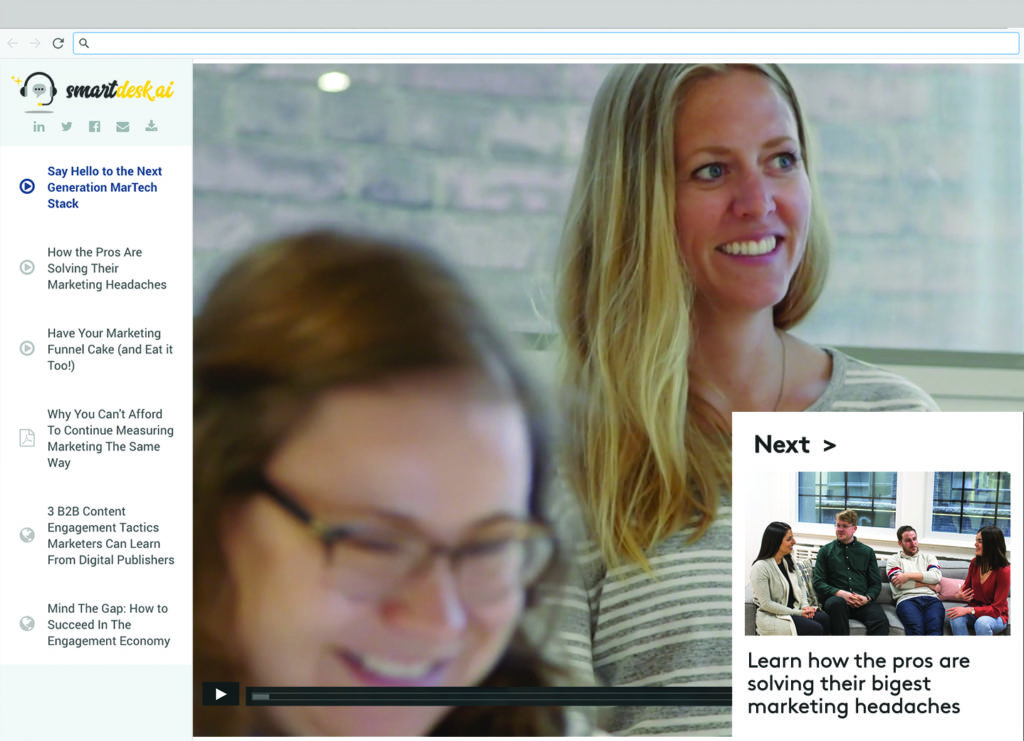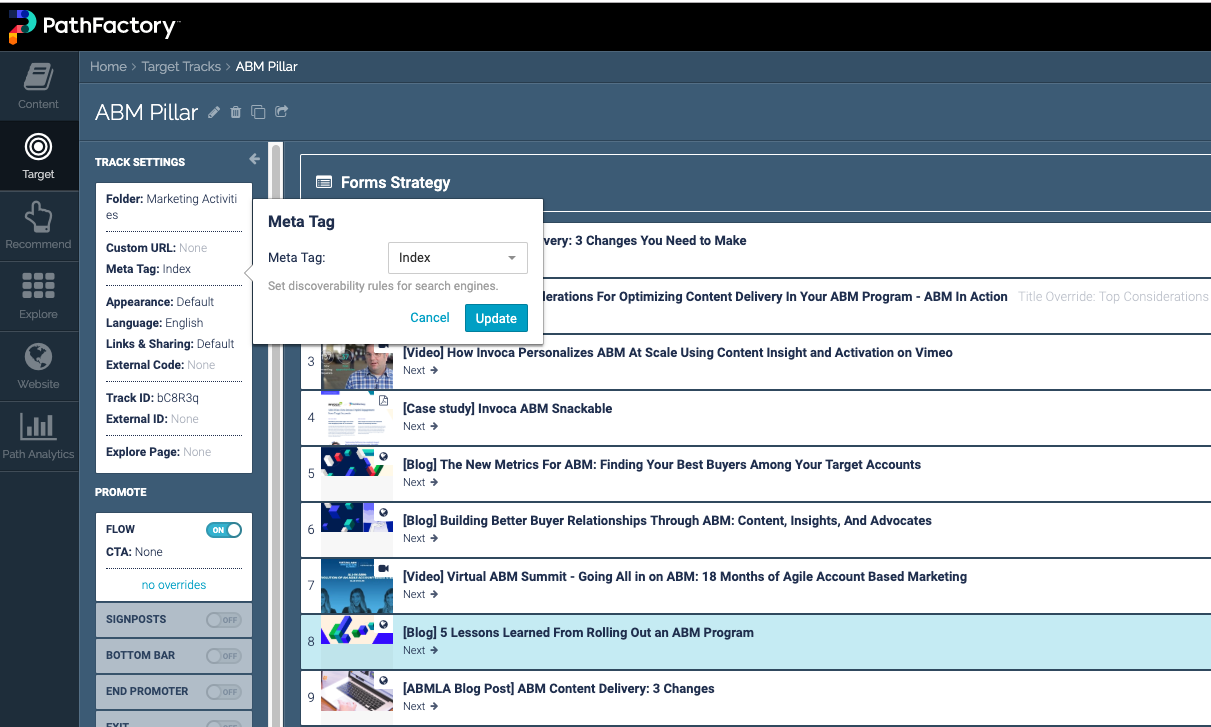
How Do PathFactory Content Tracks Impact Your SEO?

July 31, 2019
When you’re buying a new laptop, or planning a trip, where’s the first place you go?
If you’re like most people, the answer is Google.
Search engines have become the go-to place to begin researching almost anything. Your prospects are no different when they’re researching a purchase decision. That’s why it has become so crucial to make sure your brand’s content ranks on Google, so you can send qualified leads to your website.
In this blog, I’ll give a quick overview of SEO. Then, I’ll explain how PathFactory’s Content Track interact with your SEO strategy.
How SEO works
Search engine optimization, or SEO, is the process of optimizing your content so it appears prominently in more search results to maximize traffic to your website.
Google uses crawlers (also known as robots) to index pages on the web. For a page to be indexed by search engine robots (and hence searchable by your audience), it needs to either be linked from a page that has already been indexed, or a sitemap needs to be submitted to Google Search Console.
Google, which gets more than 90% of all search traffic, uses artificial intelligence and its own proprietary algorithms like PageRank and RankBrain, to give users the most relevant web pages for the keywords they search.
Mastering SEO as a marketer is a bit of an art and a bit of a science. Let’s take a quick look at the factors that will set you up for success, and make sure your key pages rank for relevant searches.
Success factors for SEO
There are 3 main success factors for SEO:
1. On-page optimization
On-page optimization involves choosing a keyword for each web page and making sure all metadata is optimized for that term. Areas to optimize include title tags, heading tags, meta description, alt text on images, body copy, and URL. The quality of your content, including copy, images, and video will also help your pages rank.
2. Off-page optimization
Off-page optimization is all about getting backlinks pointing to your page. When relevant, high-quality pages link to your page, this signals to Google that your page is high quality as well and deserves to rank highly.
3. Technical SEO
Technical SEO involves making sure your pages perform highly in terms of loading speed, site structure, URL structure, and more.
It’s worth noting that although these are widely accepted as conventional wisdom, Google frequently updates its algorithms, which means SEO is always a moving target. Plus, Google is notoriously secretive about the factors that boost SEO visibility, so it’s often a matter of debate what the true best practices are.
SEO and PathFactory Content Tracks
A PathFactory Content Track is simply a sequence of content packaged together that encourages prospects to binge—or read more than just a single asset. PathFactory Content Tracks are complementary to your website, and can help enhance how you educate your prospects in many ways on your website.
How does PathFactory affect your content? Think of a PathFactory Content Track as a container that you place your content in.

This means that while a Content Track provides a wrapper that allows you to package assets together, your traffic is still sent to the original source page (whether it’s your own content or 3rd party content.) PathFactory also stores and hosts PDFs and images uploaded directly to the content library, and renders them to your visitors in the aforementioned wrapper.
Or, from the perspective of your web browser, think of it as an HTML element that points to your content.
Does this mean it duplicates my content?
Short answer: no, your content isn’t duplicated.
Your original content is rendered in PathFactory using an iframe. Iframes don’t give search engine robots an alternative URL for your content, which is the definition of duplicate content. Rather, PathFactory points to your underlying source URL, while displaying the content in a way that makes it easier for prospects to binge-consume it. (However, should you wish to be extra careful, you can add a canonical link element to the meta tags via your PathFactory settings.)
For example, if you have a web page with the URL yourcompany.com/apples, and it lives at yourcompany.lookbookhq.com/fruits-apples inside PathFactory, then search engines see the latter as an iframe that references the former.
In summary, search engines do not see your PathFactory content as a duplicate or replacement of its original source content but, rather, as a link to your source content. SEO experts believe that iframes have a neutral effect on your SEO.
But what does this actually mean for the SEO of my content?
PathFactory should have a neutral impact on your SEO. It won’t negatively impact the SEO of your content in any way since it won’t require you to migrate your content to a new CMS as some Content Experience platforms do.
It’s your choice whether or not you want your Content Tracks to be visible to search engines or not.
It’s your choice whether or not to index your Content Tracks. Or, you can choose to index some tracks, and not index others through an easy toggle in your Settings section for each track. (Read more about how to do this here.)
How to make your Content Tracks SEO-friendly
If you do choose to index your Content Tracks, here are a few practical tips and tricks to make sure they’re optimized for search.
1. Assign your Content Tracks metadata, such as title tag and description
Adding a title tag and meta description to your Content Track will help search engine crawlers accurately determine what your content is about and rank them for relevant searches. (Learn how to do this using external code in this article.)
2. Give your Content Tracks custom URLs
You can set custom URLs for your Content Tracks and add assets in PathFactory. Optimizing URLs around keywords is a best practice because search engine algorithms factor this in when ranking your pages. For example, yourcompany.lookbookhq.com/fruits-apples would be better for SEO than yourcompany.lookbookhq.com/fts-apps-1. You can also use your company’s name as a custom subdomain, which provides additional context for Google’s crawlers to help categorize your content.
Summing up
Following these best practices can help improve the organic search rankings of your Content Tracks. A solid SEO strategy is a great channel for attracting qualified website visitors at all funnel stages. While on page, off page, and technical SEO are all ingredients of a winning SEO strategy, delivering high-quality content that serves the needs of your prospects should always be the foundation.








We’ve got internal teams who are strong proponents of indexing pdf documents. Since PathFactory does not allow for the iframe to be index, what is your recommendations on how to accommodate for this request?
Hey David! Thanks for checking out the blog! To answer your question: By default, PathFactory does not prevent the iframe url of any asset from being indexed in search engine results. The only time our platform prevents an iframe URL from being indexed is if the client implements custom code that instructs the search engine to not index the iframe URL. However, most search engines will look at the source of the content being presented in the iframe and attribute the traffic to that URL. If your team is currently using any meta tags that they believe would improve an asset ranking in search results, those same tags could be used within PathFactory. If you have any questions or want to chat further, feel free to reach out to [email protected].
I don’t think I am so concerned about a negative impact but I am looking for a helpful impact. We are very focused on drawing visitors in on our website but I do not see how this will help us in a big way as we are iframing in our existing content. Other than indexing our content tracks, has anyone else done any coding within AEM to support the mega SEO garnered from deep and rich content pages using Path factory. My initial impression is that this is really a nurture tool v. an organic content hub solution.